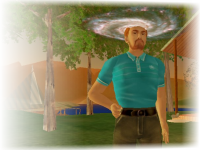When Stars Collide
When I’ve given talks about colliding galaxies, I always start out by pointing that that the stars within a galaxy basically never collide with each other. This is, of course, an oversimplification….
You may have seen a “scale model” of the Solar System. It gives you a sense of how amazingly spread out things are… especially after you’ve made the hike to get to Saturn, never mind Uranus, Neptune, or the Kuiper Belt. But you never see a scale model of the nearby stars. Why? because things are even more amazingly spread out. Suppose I wanted to make such a scale model, and, here in Nashville, TN, I used a tennis ball to represent the Sun. To represent the nearest star, α Centauri, I’d need another tennis ball that is in New York City. Stars are really, really far apart from each other. Our galaxy is mostly empty space. (Well, actually it’s mostly dark matter, but within the disk of the galaxy, the mass density is more stars than dark matter. And, between the stars, there is interstellar gas, but the density of that gas is much lower than the density of gas in the best vacuum chamber we’ve built on Earth.)
However, there are places where this isn’t strictly true. We see some stars in globular clusters that are more massive than stars that have any business still being around in that globular cluster. (That is, globular cluster stars were all formed 11-13 billion years ago. Stars with higher mass have shorter lifetimes, so any star above a certain mass cutoff isn’t seen in a globular cluster.) One very likely explanation for this is that these stars are the result of a merger between two lower-mass stars.
It may also be possible in some very rich young clusters of stars that stars may collide with each other before the cluster disperses. The black hole at the center of our galaxy may very rarely “eat” a star. (No, we haven’t seen this happen.)
Last week, Jamie Lombardi of Allegheny college gave a seminar in Second Life as part of the MICA professional seminar series entitled “The Hydrodynamics of Runaway Collisions.” At the very beginning of the talk, he had to clarify that he was in fact talking about colliding stars. I give a lot of public-outreach astronomy talks for MICA (a different series, obviously, from the serious of professional seminars), and I have given a couple of talks about colliding galaxies. My own history as an astronomer leads me to think “collisions” to mean “between galaxies”– and the hydrodynamics, then, must be referring to the gas processes that might, say, feed an AGN.
However, cool things can happen when three stars have a close enough pass that their envelopes start to spill on to each other. Sometimes, two of the stars will merge (while the third one in the collision is ejected). Some of the gas is lost, but much of it stays behind in a more massive star. The timescale for these collisions is short enough that the stars will not evolve appreciably during the collision, so this may well be a way that you can make a star that’s more massive than what would naturally form out of star formation nowadays— especially if you can chain together several collisions. What Jamie was talking about, of course, probably only applies in very young, very rich clusters. The globular clusters in our Galaxy today are too old to have the kind of massive stars that Jamie was focusing on in his talk, and most of the star forming clusters nowadays have several orders of magnitude fewer stars than globular clusters do. But, globular clusters were once young….
